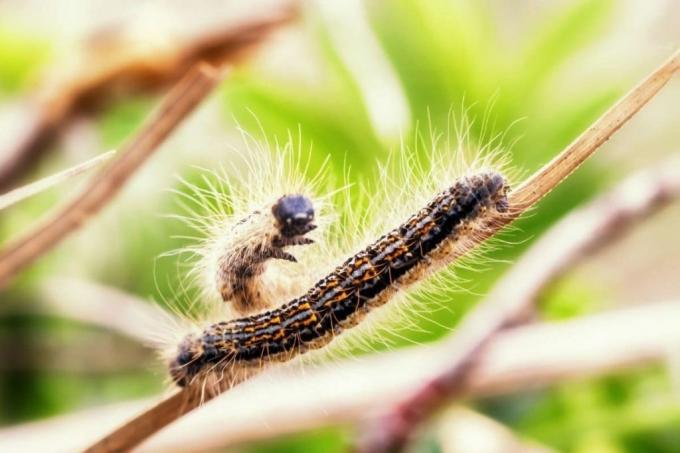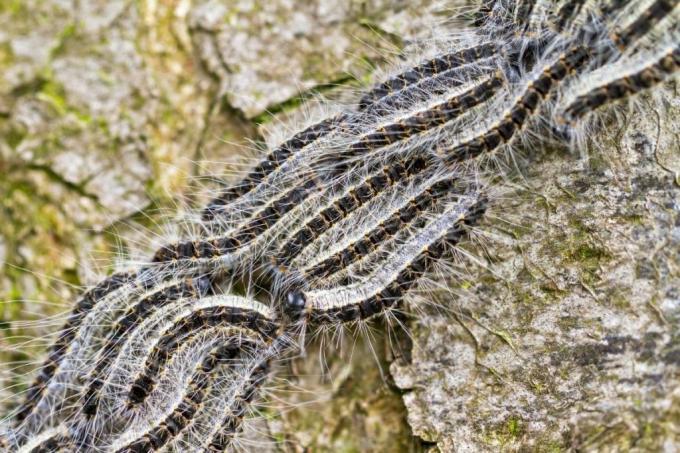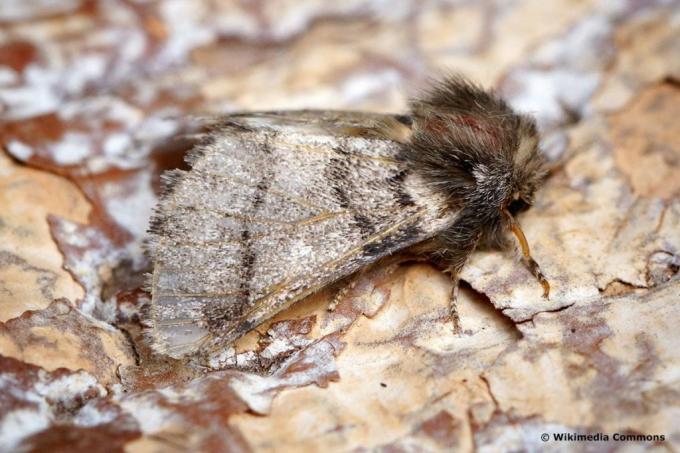
table of contents
- What are oak processionary moths?
- Damage image
- Size of the caterpillars
- colour
- Hairiness
- Locomotion
- Nests
- Diffusion time
- activity
- Rash & allergic reactions
- butterfly
- frequently asked Questions
Recognizing oak processionary moths and their caterpillars is not easy, but important. Because they can not only be dangerous to plants. We show which features help to differentiate.
In a nutshell
- adults are difficult to distinguish from other moths
- Locomotion of the caterpillars is unusual and noticeable
- Leaves are almost never attacked
- Nests are found on oaks
- Period of occurrence can be an indication
What are oak processionary moths?
It is a matter of a kind of moththat feed on oak leaves and shoots and thus lead to a complete bare of the trees. In some regions they therefore pose a considerable risk to entire forest sections.
Because when the oaks no longer have any leaves, photosynthesis can no longer be carried out. In addition, the regulation of the moisture balance is negatively influenced.
This weakens the trees and can directly cause them to die. This is often the case, especially with very young plants. However, by reducing the number of processes taking place, the oaks also become more susceptible to other pests and diseases. Mainly the caterpillars of the oak processionary moth can therefore indirectly cause the trees to die.

Damage image
Oak processionary moths can be recognized by the damage they leave behind. Even in mixed forests, they feed on oak leaves and the young shoots of the trees, which is extremely noticeable.
If there are signs of feeding and shedding only on oaks, this is a clear indication of a strong infestation with this species of moth and its caterpillars.
Size of the caterpillars
The larvae go through several stages of development. As a result, the size can of course vary. In the last stage they reach a length of up to five centimeters. Because of this size, they are very quickly noticeable. This is not just due to the length alone. Due to their grouping when moving, they can in some cases hardly be overlooked.
colour
Depending on the stage of development, the color of the caterpillars can change. Possible are:
- brown with a light line on the back
- dark brown all over
- light sides with dark brown back
This makes it difficult to differentiate between harmless species. The color alone should therefore not be used as a criterion.
Hairiness
One of the most important distinguishing features is the hairiness of the caterpillars. This consists of different hairs or bristles:
- Stinging hairs
- dark, short hairs
- long, light to white hairs
Most noticeable are the long, bright bristles. They stand out clearly and form a kind of wreath around the entire body.
Note: Beware of stinging hairs, they can be dangerous for both humans and pets.
Locomotion
In relation to the most noticeable features, the behavior of the caterpillars while moving is particularly noticeable. Because these can hardly be found individually. Instead, they wander in groups. For this reason they are also called oak processionary moths. Because they move on as a procession.
At the top is a single larva that acts as a leader, so to speak. This results in the following characteristics:

- formed as an arrow
- Occur in larger groups
- easily recognizable and easy to distinguish from other species
- mainly found on tree trunks
Nests
The caterpillars spin nests that are vaguely reminiscent of very dense cobwebs. These are mainly found at:
- Branches
- Shoots
- Tribes
- Shoots
The weaves of the oak processionary moth can be recognized by their different shapes. For example:
- as a belt around an oak trunk
- seldom stuck under leaves
- wrapped around branches and twigs
The weaves can sometimes hang down in threads and are so dense that they initially appear silky.
Note: The nests change color relatively quickly and are then difficult to distinguish from the bark. On closer inspection, however, the threads are occasionally noticeable.

Diffusion time
The caterpillars are found mainly in late spring to early summer. The activity and speed of development, however, depends on the climate and the current weather. In years with mild winters and warm springs or generally mild climates, the larvae can hatch very early and pupate quickly. They spread rapidly as early as March and at the latest by the end of April.
activity
The adult moths are nocturnal, whereas the caterpillars move and feed mainly during the day. It is therefore much more difficult to spot the moths. However, the caterpillars can be observed on a walk in the forest, in parks or avenues.
Rash & allergic reactions
Due to the stinging hairs of the caterpillars, the oak processionary moths also pose a danger to humans and animals. A rash can occur if it comes into direct contact with the skin. In addition, the hair can also fly through the air. This means that they get into the airways and eyes even without direct contact. This can lead to allergic reactions. Including:
- burning, watery and reddened eyes
- cough
- itching
- Sneeze
- Redness
- Swelling
- Difficulty breathing
- increased secretion and tear formation
Therefore:
- Avoid close proximity to the caterpillars
- Keep pets and children away urgently
- Do not touch
- wash after accidental contact or short distance
If the symptoms persist or if they are very severe, a doctor or veterinarian must be consulted.
butterfly
Recognizing the adult oak processionary moths is not only difficult for laypeople. Because of their size and color, the animals can hardly be distinguished from other nocturnal butterflies. The characteristics are:

- brown-gray coloring of the wings
- Pattern in the form of lines
- nocturnal
- reddish-brown body
- 25 to 35 millimeters long
frequently asked Questions
There is no obligation to do so. Nevertheless, it makes sense to report an infestation on private property as well as in the forest and in parks. This means that appropriate measures can be taken at an early stage in order to keep the damage as low as possible. Possible reporting points are the public order office and the green space office.
Yes, the oak processionary moth can be combated by various means and measures. Including, for example, the suction or use of natural enemies. However, the infestation is often only noticed late, so that trees are already showing considerable damage and may have to be felled. This may be necessary to prevent further spread.
Around late summer, the females of the species fly between two and ten kilometers. They are looking for a suitable host tree and lay their eggs in packets of 30 to 300 on the one to two-year-old branches.



